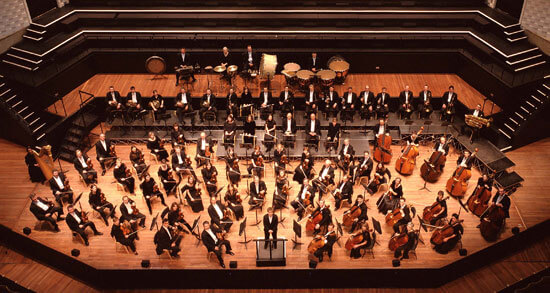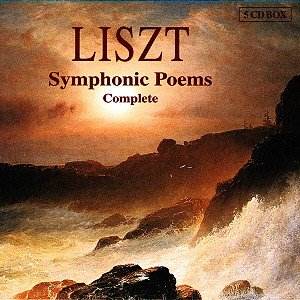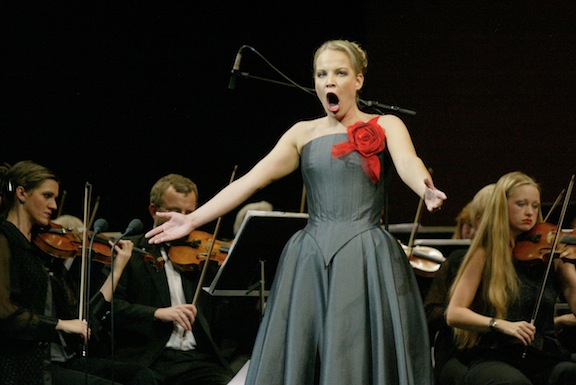Genres of Western Classical Music
Solo Recital
A musical performance highlighting:* a single performer
(e.g. piano recital - Ständchen (Schubert/Liszt))
* a performer accompanied by a pianist
(e.g. violin recital - Ave Maria (Bach/Gounod))
(e.g. aria - Komm, lieber Mai (Mozart))
* a performance of the works of a single composer
(e.g. Chopin on his 200th birthday)
Duet or duo recital
A duet has 2 performers, most often 2 singers or pianists:* "piano duet" or "piano four hands": 2 pianists on 1 piano
(e.g. Schubert's Marches Militaires)
* "piano duo": 2 pianists on separate pianos
(e.g. Mozart's Sonata K.448)
* others:
(e.g. Fauré's Fantaisie flute-harp duo)
In Renaissance music, a duet specifically intended as a teaching tool, to be performed by teacher and student, was called a bicinium.
Concerto
* usually one solo instrument accompanied by an orchestra(e.g. Mozart's Piano Concerto No.21)
* usually has 3 movements (fast, slow, fast)
A sonata also has 3 movements (fast, slow, fast).
Symphony
* an extended musical composition generally scored for orchestra* many symphonies have 4 movements (fast, slow, a minuet/scherzo, fast), usually at least 1
(e.g. Beethoven's Symphony No.2)
Symphonic poem
- aka tone poem
* usually 1 movement in which the content of a poem, short story, novel, painting ... is illustrated
(e.g. Sibelius's Finlandia)
* first applied by Liszt to his 13 works in this vein
* Beethoven and Mendelssohn began to use the term to refer to independent instrumental works
(e.g. Tchaikovsky's 1812 Overture)
* they may be extracts from a ballet (Nutcracker Suite) incidental music to a play (L'Arlésienne Suites) opera film (Lieutenant Kije Suite) entirely original movements (Holberg Suite, The Planets).
* In the Baroque era the suite was more precisely defined, with the pieces unified by key, and consisting of dances usually preceded by a prelude or overture. The suite was also known as Suite de danses, Ordre (the term favored by François Couperin) or Partita.
* In the 18th century, the term may refer to the entire suite (J.S. Bach's orchestral suites)
A form of sacred musical composition, it is a choral composition that sets the invariable portions of the Eucharistic liturgy to music
* mostly in Latin for the Catholics
* also written in the languages of non-Catholic countries
(e.g. English for the Church of England)
* can be a cappella, or can be accompanied
* many later Masses were never intended for an actual mass
* usually 1 movement in which the content of a poem, short story, novel, painting ... is illustrated
(e.g. Sibelius's Finlandia)
* first applied by Liszt to his 13 works in this vein
Overture
* originally applied to the instrumental introduction to an opera
(e.g. Prelude to Bizet's Carmen)* Beethoven and Mendelssohn began to use the term to refer to independent instrumental works
(e.g. Tchaikovsky's 1812 Overture)
Suite
* an ordered set of instrumental/concert band pieces* they may be extracts from a ballet (Nutcracker Suite) incidental music to a play (L'Arlésienne Suites) opera film (Lieutenant Kije Suite) entirely original movements (Holberg Suite, The Planets).
* In the Baroque era the suite was more precisely defined, with the pieces unified by key, and consisting of dances usually preceded by a prelude or overture. The suite was also known as Suite de danses, Ordre (the term favored by François Couperin) or Partita.
* In the 18th century, the term may refer to the entire suite (J.S. Bach's orchestral suites)
Missa
* mostly in Latin for the Catholics
* also written in the languages of non-Catholic countries
(e.g. English for the Church of England)
* can be a cappella, or can be accompanied
* many later Masses were never intended for an actual mass
Requiem or Requiem Mass
- aka Mass of/for the dead (Latin: Missa defunctorum / pro defunctis)
A Mass celebrated for the repose of the soul or souls of one or more deceased persons
* It is frequently celebrated in the context of a funeral.
* The Mass and its settings draw their name from the introit of the liturgy (e.g. Mozart's Requiem)
(2) ternary form (presentation, digression, re-presentation; A-B-A)
(3) theme & variations
(4) rondo (e.g. Mozart's Rondo for piano & orchestra)
(5) fugue (flee/chase; a theme repeated at different pitches; see Art of Fugue; e.g. Art of Fugue)
(6) ostinato (obstinate; i.e. a short musical pattern that is repeated throughout; e.g. Ravel's Boléro)
A Mass celebrated for the repose of the soul or souls of one or more deceased persons
* It is frequently celebrated in the context of a funeral.
* The Mass and its settings draw their name from the introit of the liturgy (e.g. Mozart's Requiem)
Operatic Singing
* Singing onstage, without operatic stage set-up or acting (e.g. Muzzeta's Waltz in Puccini's La bohème)Glossary of musical terminology
Harmony
Harmony is the result of combining musical notes, played simultaneously to form a chord. Some chords sound dissonant (e.g. C-D, C-B), others harmonious/consonant.
In conventional tonal music, certain phrases end in “cadences”, whose common examples are:
* the perfect cadence, which sounds conclusive
* the imperfect cadence, which sounds inconclusive and demands some kind of continuation
* the plagal, which sounds serious and final and is often used for the “Amen” of a hymn.
Musical form
The two basic forms are binary (A-B) and ternary (A-B-A).
Variants of these have the following format types:
Six format types
(1) sonata form ([optional introduction,] exposition, development, recapitulation [,optional coda])(2) ternary form (presentation, digression, re-presentation; A-B-A)
(3) theme & variations
(4) rondo (e.g. Mozart's Rondo for piano & orchestra)
(5) fugue (flee/chase; a theme repeated at different pitches; see Art of Fugue; e.g. Art of Fugue)
(6) ostinato (obstinate; i.e. a short musical pattern that is repeated throughout; e.g. Ravel's Boléro)
| typically used format types | tempo | symphony / string quartet (4 movements: fast-slow-slow-fast) | concerto / sonata (3 movements: fast-slow-fast) |
|---|---|---|---|
| (1) sonata allegro form | fast | Mvt. 1, Finale | Mvt. 1, Finale |
| (2) ternary form | slow | Mvt. 2, Mvt. 3 (minuet/scherzo) | Mvt. 2 |
| (3) theme & variations | slow | Mvt. 2 | Mvt. 2 |
| (4) rondo | slow | Mvt. 2 | Mvt. 2 |
| (3) theme & variations | fast | Finale | Finale |
| (4) rondo | fast | Finale | Finale |
| (5) fugue | fast | Finale | Finale |
| (6) ostinato | fast | Finale | Finale |
From slowest to fastest:
- Larghissimo – very, very slow (19 BPM and under)
- Grave – slow and solemn (20–40 BPM)
- Lento – slowly (40–45 BPM)
- Largo – broadly (45–50 BPM)
- Larghetto – rather broadly (50–55 BPM)
- Adagio – slow and stately (literally, "at ease") (55–65 BPM)
- Adagietto – rather slow (65–69 BPM)
- Andantino – slightly slower than andante (although in some cases faster) (78–83 BPM)
- Andante – at a walking pace (84–90 BPM) (about the heart rate at an average walking speed)
- Andante moderato – between andante and moderato (90–100 BPM)
- Marcia moderato – moderately, in the manner of a march (83–85 BPM)
- Moderato – moderately (100–112 BPM)
- Allegro Moderato - moderately fast (112-116)
- Allegretto – close to but not quite allegro (116–120 BPM)
- Allegro – fast, quickly, and bright (120–160 BPM) (molto allegro is in the allegro range)
- Vivace – lively and fast (132–140 BPM)
- Vivacissimo – very fast and lively (140–150 BPM)
- Allegrissimo (or Allegro Vivace) – very fast (168–177 BPM)
- Presto – extremely fast (180–200 BPM)
- Prestissimo – even faster than Presto (200 BPM and over)
Dynamics
- Pianissimo (pp) -- Very quietly
- Piano (p) -- Quietly
- Mezzo piano (mp) -- Moderately quietly
- Mezzo forte (mf) -- Moderately loudly
- Forte (f) -- Loudly
- Fortissimo (ff) -- Very loudly
Source: Wikipedia



No comments:
Post a Comment